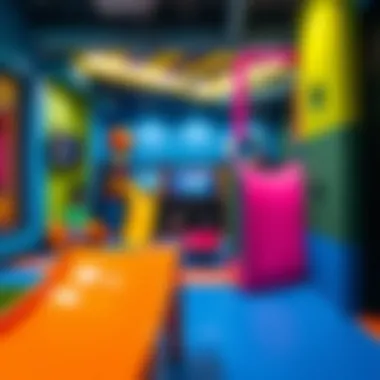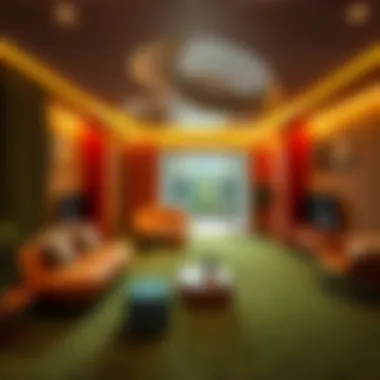Exploring Play Rooms in Dubai: An In-depth Overview


Intro
The concept of play rooms in Dubai isn't just about creating spaces for leisure or entertainment; they're rapidly evolving into essential components of modern living. This article takes a closer look at how these unique spaces are reshaping both residential and commercial properties in this bustling emirate. With a diverse lifestyle and ever-changing demographics, it's imperative for investors and homeowners to grasp the significance of play rooms, how they're designed, and their multifaceted applications.
These areas, whether dedicated to children, adults, or community gatherings, hold the potential to enhance property appeal, foster social interactions, and ultimately influence real estate value.
In this overview, we will examine current market trends, explore investment opportunities, and consider design innovations that underline the importance of play rooms in Dubai's contemporary lifestyle.
Market Trends
Current Real Estate Landscape
Dubai's real estate landscape is quite dynamic. As the city continues to attract a diverse population, the demand for properties with personalized features has risen significantly. Developers are now focusing on creating homes that not only offer shelter but also cater to recreational needs. Play rooms, often regarded as a luxury, are being integrated into both residential and commercial properties, reflecting the evolving priorities of new buyers and residents.
More so, urban planners in Dubai are starting to recognize the value these spaces add in community-centric developments. Whether it be a cozy corner for kids to play or a chic lounge for adults to unwind, play rooms represent a bridge between functionality and enjoyment.
Property Price Trends
With the surge in demand for play-centric spaces, we see an interesting pattern in property prices. Properties that boast integrated play rooms often command a premium. Buyers are willing to invest more for homes that foster family interaction and leisure activities. Moreover, studies indicate that neighborhoods featuring communal play spaces—like parks or creative play zones—generally reflect higher property values compared to their counterparts.
- Key Observations on Property Prices:
- Homes with dedicated play rooms have shown a price appreciation of nearly 10-15% over the past few years.
- Properties located in community-focused developments, with shared play areas, tend to attract more buyers.
- The demand for spacious play rooms has led to a rise in similar architectural styles among newer properties.
"As we navigate through a new era of living, it’s becoming clear that play rooms are more than just a bonus; they are becoming essential for modern family life in Dubai."
Investment Opportunities
High-Return Areas
Identifying neighborhoods that promise high returns on investment can be daunting. However, areas like Dubai Marina and Jumeirah Lake Towers (JLT) have emerged as hotspots, making them prime for investors willing to include play rooms in their portfolio. These locales attract families with children and young professionals who appreciate living spaces that offer recreational opportunities.
- Factors to Consider for Investment:
- Property value stability in established neighborhoods versus emerging areas.
- Proximity to schools, parks, and community centers that enhance the play experience.
- Trends in community-driven designs that emphasize shared spaces.
Upcoming Developments
The landscape of Dubai’s real estate is not static; it’s ever-evolving. Keep an eye on upcoming developments that incorporate play rooms as a central design element. Projects in areas like Dubai Hills Estate and Dubai South are investing heavily in residential properties that meld luxury with leisure. These developments often offer diverse amenities tailored for families, including large play areas and community event spaces.
As the interest in family-centric living continues to grow, future developments will likely incorporate even larger and more imaginative play rooms to address the needs of the market.
Foreword to Play Rooms in Dubai
Understanding play rooms in Dubai offers insight into a unique segment of modern living, reflecting cultural nuances and social dynamics. They are not merely spaces for children or adults but represent a shift in how people perceive leisure and community interaction within urban environments. The incorporation of play areas in residential and commercial contexts is gaining traction, becoming a crucial aspect of Dubai's evolving lifestyle.
Investors and homeowners alike find play rooms increasingly attractive due to their potential impact on property value and community engagement. They highlight a commitment to quality of life, which resonates well with both locals and expatriates. By fostering social interactions, these spaces encourage a sense of belonging within the fast-paced city landscape.
Definition and Purpose
Play rooms can be broadly defined as specially designed spaces that facilitate recreational activities for individuals of all ages. Their purpose goes beyond mere entertainment; they serve as platforms for skill development, socialization, and even mental well-being.
In children's play areas, for instance, these rooms are equipped with interactive toys and games aimed at improving cognitive abilities while fostering creativity. For adults, the purpose shifts towards relaxation and social interaction, often featuring fitness equipment, art supplies, or communal spaces. Ultimately, the goal of play rooms is to enhance both personal and communal experiences, making daily living more enjoyable and fulfilling.
Historical Context in Dubai
The evolution of play rooms in Dubai can be traced through the city’s rapid development over the past few decades. Initially, recreational spaces were limited to public parks and facilities, designed primarily for children. However, as the population began to diversify and grow, the demand for more innovative recreational options surged.
Historically, Dubai's cultural fabric has emphasized community and leisure. The introduction of play rooms can be seen as a response to the growing need for family-friendly environments that cater to various age groups. Over time, both public and private sectors have recognized the importance of these spaces. They have become pivotal in enhancing lifestyles, offering safe havens for children and adults to unwind and connect. As the city continues to grow, so too does the concept of play rooms, evolving to meet the changing needs of its inhabitants.
In summary, exploring play rooms in Dubai is not just about understanding a trend; it's about recognizing their integral role in shaping urban living and fostering a vibrant community.
"Play rooms stand as symbols of modern lifestyle; they reflect our collective desire for interaction, creativity, and balanced living."
To delve deeper into the elements defining the success and integration of play spaces within both residential and commercial entities in Dubai, it’s essential to examine the variety and designs that cater to these evolving needs.
Types of Play Rooms
The concept of play rooms goes beyond mere leisure and recreation; it's about fostering an environment where people of all ages can thrive mentally, socially, and physically. Whether these spaces cater to children, adults, or the community at large, each type brings unique benefits to the table. Understanding the different types can help stakeholders make informed decisions about development and investment opportunities in Dubai's evolving landscape.
Children's Play Areas


Children's play areas are, unsurprisingly, fundamental to nurturing the creativity and social skills of young ones. These spaces serve not only as a source of entertainment but also as a foundation for lifelong learning and development. Investments in these areas can yield significant payoffs for home values and community prestige.
Safety Considerations
Safety considerations stand at the forefront when designing children's play spaces. A major aspect is the incorporation of soft landing surfaces, such as rubber mats or grass, to minimize injuries from falls. These designs are crucial in helping parents feel at ease. The key characteristic of investing in safety features is that they create a secure environment that encourages free play. This can increase the footfall in residential areas, enhancing community interaction.
However, safety can sometimes come at a premium; high-quality equipment often requires higher initial expenditure. Still, the trade-off is worthwhile when one considers the peace of mind provided to families.
Popular Themes
Themed play areas are another significant trend. Options range from pirate ships to jungle themes, and much in between. These themes captivate children’s imaginations, stimulating both play and learning. A key advantage of popular themes is that they draw in a larger demographic, facilitating community engagement. Such themes can also be adjusted according to cultural elements, allowing for a more localized feel.
On the flip side, creating such elaborate themes can involve complex planning and higher costs, which might be a drawback for developers.
Influence on Child Development
The influence of play spaces on child development cannot be overstated. These environments allow for organic social interaction and skill-building. A well-designed children's play area fosters physical activity and encourages problem-solving and teamwork among peers. Furthermore, exposure to varied activities can help in broadening cognitive capabilities.
However, not all children might thrive in busy, themed environments. Some may prefer the simplicity of nature-based spaces that encourage creativity in different ways. The challenge is to find a balance that serves the diverse needs of all children.
Adult Recreation Spaces
While play rooms are often seen as domains for children, adult recreation spaces are gaining traction too. These areas aim to support adults in leading balanced lifestyles and fostering social networks. They come in various forms, taking into consideration fitness, creativity, and social interaction.
Fitness and Wellness Facilities
Fitness and wellness facilities are becoming staples in adult recreation spaces. They offer not just gyms but holistic wellness options including yoga studios and wellness programs that promote mental health. The key characteristic is the focus on comprehensive well-being, encouraging members to participate in both physical and mental growth.
These facilities are particularly appealing in urban areas where space is limited, driving membership numbers up. However, the initial setup costs and equipment choices can be daunting for investors. Still, the lasting return on investment through higher property values and happier residents can be worth it.
Art and Creative Spaces
Art and creative spaces represent another facet of adult recreation that merges expression with mental relaxation. Paint studios, ceramics, and pottery workshops stand out as popular options that not only allow for individual creativity but also promote community bonding. Highlighting the key characteristic here is that such environments stimulate creative thought and personal growth.
However, managing these spaces can be tricky as they often require skilled facilitators and adequate resources. A poorly managed creative space can lead to reduced engagement, making it essential to prioritize quality staff to maintain these areas.
Social Interaction Areas
Social interaction areas provide adults with venues to connect and converse, often leading to business networking and friendship formation. These spaces could include lounges, cafes, and collaborative workspaces. The key characteristic of these areas is their focus on fostering relationships; they create opportunities for social engagement.
On the downside, if these spaces are poorly designed— for instance, lacking in comfortable seating or cohesive layout— the intended purpose can be compromised. It's crucial to prioritize effective design and ambiance to cultivate a welcoming environment.
Community Play Zones
Community play zones signify a commitment to inclusivity and social development. These spaces encourage various demographics to participate in recreational activities while emphasizing cultural integration. They can provide opportunities for interaction, learning, and entertainment, aiding community cohesion.
Integration of Cultural Elements
Community play zones are places where cultural elements come alive. Facilities designed with local traditions in mind help to foster a sense of belonging among residents. The key feature is that they present an opportunity for cultural exchange and enrichment. Additionally, engaging with local artisans can embed cultural stories within play zones, enhancing their thematic appeal.
However, the challenge can be ensuring that these elements resonate with diverse groups, particularly in a multicultural setting like Dubai. It necessitates thorough research and community involvement in the design phase.
Public Engagement Initiatives
Public engagement initiatives breathe life into community play zones. Activities and events aimed at bringing people together can include workshops, performances, and seasonal festivals. The aim is to transform these spaces into lively hubs of community engagement. The primary advantage is that such initiatives significantly enhance community spirit and feedback from residents can lead to ongoing improvements.
Yet, organizing events can strain resources and require efficient planning to avoid overwhelming local participants. To avoid logistical pitfalls, enthusiastic volunteers can be key to ensuring these events succeed.
Through conscientious curation of play spaces, Dubai can promote vibrant lifestyles and community interaction, appealing to families and businesses alike.
Design Considerations for Play Rooms
Creating a play room is more than just throwing together some toys and furniture; it’s an art form. Design considerations for play rooms in Dubai are crucial as they directly impact how users, whether children or adults, interact with these spaces. A thoughtfully designed play room enhances user experience, promotes safety, and encourages creativity. Let’s delve into the key elements of design that can elevate play rooms into multifunctional and enjoyable spaces.
Aesthetic Aspects
Color Psychology
Color isn’t merely decorative—it's a catalyst for emotion and behavior. Utilizing color psychology in play rooms can drastically influence mood and creativity. Bright colors, such as yellows and reds, can induce excitement and energy, while softer shades like blues and greens promote calmness. This strategic use of color helps set the tone of the environment, making it an essential design element in play spaces. One unique feature of employing color psychology is how different hues can evoke memories or feelings, allowing the space to resonate with users on a personal level.
A potential disadvantage, however, is the overuse of certain colors which could create an overwhelming sensory experience, making a careful balance essential. In this bustling city where aesthetics are paramount, a well-thought-out color scheme helps a play room stand out and feel inviting.


Materials Used
Material selection can make or break a play room’s design. The right materials contribute not only to the look but also to the safety and durability of the space. For instance, soft flooring materials, such as foam tiles or padded carpets, can limit injuries during playtime, an essential consideration for any parent or developer.
Moreover, eco-friendly materials are gaining traction as they align with sustainability goals. Bamboo or recycled rubber can serve as delightful choices, offering a unique feel while being gentle on the environment. The distinctive characteristic of these materials is their longevity and ease of maintenance, providing extensive benefits in the long run. However, it is necessary to avoid materials that might harbor allergens or chemicals, prioritizing health and safety in design.
Functional Layout
Space Optimization
In the world of play rooms, space optimization is pivotal. Effective layout can ensure that every inch serves a purpose, allowing for movement and engagement rather than clutter. The key characteristic of this approach lies in creating distinct zones that cater to different activities—like a reading nook, an art corner, or a play area. This strategy not only maximizes the space but also encourages children to explore various interests within a single room.
A unique benefit of optimized space is the fluidity it offers users, especially in smaller apartments or homes common in Dubai. However, a layout that isn’t planned carefully can lead to a feeling of confinement, hindering the flow of activities and interactions. Balancing functionality with aesthetics will provide a seamless play experience.
Accessibility Features
An inclusive play room is one that caters to all users, including those with disabilities. Accessibility features are essential, ensuring that everyone can enjoy the space equally. Ramps, wide doorways, and accessible furnishings enhance usability, allowing fun for all age groups and abilities.
The value of these features is evident; it fosters a sense of community and acceptance. On the flip side, designing for accessibility requires additional planning and resources, which might be overlooked in more conventional layouts. Ultimately, incorporating these elements signals a commitment to inclusivity, enriching the play room’s appeal.
Innovation in Play Room Design
Technology Integration
Technology integration within play rooms is transforming the landscape. From interactive play panels to tablet stations, technology can enhance cognitive development and social interaction. One remarkable aspect of tech integration is its ability to adapt to users' varying interests and skill levels, keeping engagement levels high.
However, there exists a downside—over-reliance on technology can detract from traditional play techniques and organic social interactions. Striking a balance between digital and hands-on activities is crucial for nurturing well-rounded developmental experiences.
Sustainable Practices
Sustainability has become a key consideration in play room design, especially in a city like Dubai, where environmental concerns are increasingly pertinent. Sustainable practices involve using renewable resources and eco-friendly products, resulting in a space that is not only fun but also responsibly built. The hallmark of this approach is its long-term impact on both the environment and the health of users.
While sustainable choices may come with higher upfront costs, the long-term benefits—such as reduced energy consumption and healthier air quality—can outweigh these expenses. Nonetheless, the challenge lies in sourcing materials that meet these criteria while also remaining aesthetically pleasing and functional.
Ultimately, the considerations for designing play rooms in Dubai extend beyond mere visual appeal; they encapsulate functionality, safety, and a commitment to innovation that resonates with the modern family.
Market Trends in Dubai Play Spaces
The market for play spaces in Dubai is evolving, heavily influenced by the city's rapid modernization and its commitment to enhancing quality of life. These spaces are not mere afterthoughts; they are becoming central to urban planning and development. Investors and developers are increasingly recognizing the value of play areas as integral features that not only appeal to families but also enhance real estate value.
Current Demand and Supply Dynamics
In the bustling environment of Dubai, the demand for both indoor and outdoor play spaces has seen a notable uptick. Families are actively seeking residential complexes that feature dedicated play areas for their children. Parents are not just looking for basic gardens or playgrounds anymore, they are inclined towards creative and educational environments that nurture growth and learning.
- Rise in Affluent Populations: The influx of affluent residents in Dubai has propelled demand for luxury play spaces. These tend to include high-end equipment, safety features, and amenities that make for a comprehensive leisure experience.
- Urbanization and Family Structures: With spaces for play proliferating amid urbanization, providing safe and engaging environments for children has become a top priority for builders. As traditional family structures evolve, multi-generational living arrangements make play spaces pivotal for community engagement.
Investment in children’s play facilities has pushed many developers to curate innovations that prioritize safety, design, and convenience. The supply is gradually increasing to meet this demand, albeit with some disparities in different areas of the city.
Comparative Analysis with Global Trends
When comparing Dubai's play spaces to those in other significant global cities, in some aspects, Dubai leads in innovation. However, there are challenges, particularly in scaling these amenities to reflect global best practices.
- Innovative Designs: In cities like Copenhagen or Tokyo, public play spaces often emphasize nature integration and community involvement. Dubai’s spaces can draw inspiration from these models by focusing more on organic materials and creating greener environments.
- Investment Returns: Internationally, cities that invest in well-planned public play areas tend to see higher real estate value increases. As investors in Dubai become more aware, they may begin to prioritize play spaces in their proposals, recognizing them as a wise avenue to enhance property valuations.
Future Projections
Looking ahead, the trends suggest a promising future for play spaces in Dubai. As the local population becomes more health-conscious and community-oriented, the demand for interactive, multi-functional play areas will likely surge.
- Integration of Technology: Future play spaces may evolve into advanced interactive environments, integrating technology such as augmented reality to enhance the play experience. This trend emerges from a global inclination toward experiential learning in recreational areas.
- Increased Community Focus: There is also a significant shift towards creating community-centric play areas. Expect more partnerships between local government and private investors to develop spaces that cater not just to children but to families as a whole, consolidating social interactions within neighborhoods.
As Dubai continues to grow, play spaces will not only boost property values but will also enrich the community’s social fabric. They will serve as vital components that contribute significantly to the overall lifestyle in this thriving metropolis.
"The success of play spaces in Dubai will be measured not only by their economic impact but also by their ability to forge connections and create healthier environments for families."
In summary, the evolution of play spaces within Dubai reflects much broader trends in urban development. They are no longer seen as amenities but as essential building blocks of a balanced community. Investors, homeowners, and city planners alike should pay close attention to these developments as they create opportunities for innovation and growth.
Impact on Property Values
The influence of play rooms on property values is becoming increasingly significant, especially in a bustling metropolis like Dubai. Since real estate in Dubai is often viewed as a valuable investment, understanding how play spaces contribute to property value becomes essential for investors, homeowners, and real estate agents alike.
Value Addition through Play Rooms


Investing in play rooms can lead to substantial value addition for properties in Dubai. These spaces are not just areas for entertainment; they serve as investment strategies, enhancing the appeal of residential and commercial properties. Here are some specific benefits that come with developing play rooms:
- Increased Attractiveness for Families: Many families prioritize homes with dedicated play spaces. When parents see a child-friendly environment, it can heavily influence their purchasing decision.
- Enhanced Lifestyle Appeal: Play rooms cater to various age groups, offering multifunctional uses. For instance, a game room can serve as a place for both children and adults to unwind, enhancing the overall lifestyle appeal of a property.
- Potential for Higher Rental Yields: Properties equipped with recreational areas can command higher rental prices due to their desirability. In areas with a high concentration of expatriates, such features particularly catch the eye.
- Asset Longevity: A well-designed play room, built with quality materials, not just enhances immediate aesthetic value but ensures that the property remains appealing in the long run. A striking and functional space resists falling out of favor as tastes change.
In today’s market, the demand for such features is noticeably rising. Dubai's real estate landscape is increasingly characterized by competitive offerings, and play rooms can provide a distinct advantage.
Buyer Preferences
Understanding buyer preferences is essential when considering play rooms in the context of property values. As the demographics shift in Dubai, preferences are also changing:
- Focus on Family-Centric Amenities: Buyers, particularly families, are now focusing more on properties with play-friendly features. They commonly prefer homes where their children can thrive and safely engage in various activities.
- Work-Life Balance: The modern buyer values spaces that offer a good work-life balance. Play rooms contribute immensely to this aspect, funneling relaxation and entertainment into home environments.
- Integration of Community Values: Many potential buyers are also looking at how properties embody community aspects. A property featuring shared play spaces can resonate more with prospective buyers who value communal engagement and social interactions.
- Security and Safety Designs: Consideration of safety in play spaces cannot be overlooked. Buyers look for properties that offer safe environments for recreational activities, thereby contributing positively to the overall property marketability.
Property values in Dubai are not just a reflection of location or square footage, but increasingly influenced by the presence of thoughtfully designed play areas that meet modern buyer expectations.
In summary, the impact of play rooms on property values in Dubai is substantial, revealing a connection between lifestyle enhancements and real estate desirability. Whether for personal use or investment potential, understanding this dynamic is crucial for anyone involved in the property market.
Regulatory and Compliance Aspects
When it comes to play rooms in Dubai, understanding regulatory and compliance aspects is vital for both safety and legality. This segment sheds light on two primary areas: building codes and safety regulations, along with the licensing and approval processes. These regulations ensure that play spaces are not only enjoyable but also adhere to necessary safety standards. Investors, developers, and property owners should pay close attention to these facets, as they influence operational success and public trust.
Building Codes and Safety Regulations
Building codes in Dubai serve as the backbone of architectural integrity and public safety. They outline minimum standards required for the design and construction of play rooms. Adhering to these codes helps ensure that facilities are constructed robustly and safely, minimizing risk to users, especially children and vulnerable adults. Safety regulations dictate several aspects:
- Structural Integrity: All play structures must be designed to withstand significant wear and tear, ensuring they do not pose dangers during regular use.
- Materials: The choice of materials used in construction must be non-toxic and suitable for children, reinforcing both durability and health standards.
- Design Considerations: Play areas must be designed with safety in mind, incorporating fall zones, soft landing surfaces, and appropriate emergency exits.
These guidelines also extend to the supervision and management of play areas, with recommendations for trained personnel to monitor activities, further ensuring the safety of all participants. All of this not only fosters a safe environment but also builds confidence among parents and caretakers, as they can rest assured their children are in a secure space.
Licensing and Approval Processes
Navigating the world of licensing and approval processes might feel like wandering through a labyrinth, but it is essential for those looking to establish play rooms in Dubai. Securing the necessary permits can take time, but it is a crucial step in legitimizing any play facility.
- Initial Approval: Before breaking ground, developers must seek initial project approvals, which often require a detailed proposal indicating how the play room will meet local regulations and safety standards.
- Inspections: Throughout construction, multiple inspections usually occur. These inspections ensure compliance with the set building codes and safety regulations, checking everything from structural soundness to the installation of safety measures.
- Licensing Fees: There are fees associated with obtaining the necessary licenses. Understanding the financial implications of these processes will help in budgeting effectively for project launch.
- Renewals and Updates: Finally, once operational, licenses must be renewed periodically. Staying updated on any changes in laws or regulations is crucial, as failing to comply can lead to significant fines or even facility closure.
"Compliance isn’t just about avoiding penalties; it’s about ensuring a safe and enjoyable environment for everyone involved."
For investors and developers, ensuring compliance with these regulatory frameworks directly contributes to the longevity and reputation of their play facilities. Proper adherence not only meets legal requirements but also enhances the potential attractiveness of play rooms to families, which can translate into better utilization rates and, ultimately, increased returns on investment.
Case Studies on Successful Play Room Implementations
Exploring the realm of play rooms in Dubai isn't complete without examining tangible examples of success. These case studies spotlight how thoughtful design and strategic planning create vibrant play environments, serving varied demands within the community. The importance of delving into these real-world implementations lies in understanding the unique elements and considerations that make them beneficial not just for residents, but also for potential investors and developers. Each successful project provides a roadmap of lessons learned, choices made, and impacts realized.
"Well-designed play spaces can transform neighborhoods, enhancing social cohesion and elevating property values."
High-End Residential Properties
In the luxury segment, high-end residential properties are increasingly incorporating sophisticated play rooms. Such spaces appeal not only to affluent families but also to investors seeking to elevate property marketability. For instance, consider the case of Bluewaters Island in Dubai, where luxurious apartments now feature expansive children's areas, adorned with modern equipment such as climbing structures and interactive digital play installations. These intricately designed spaces bridge the gap between aesthetics and functionality.
Families residing here don't just pay for real estate; they invest in an enriched lifestyle. The presence of state-of-the-art play rooms adds a layer of appeal, particularly for buyers prioritizing community features in their homes. Moreover, these areas foster interaction, making them an attractive proposition for families looking to integrate into a vibrant neighborhood.
Community Centers and Public Parks
Community centers and public parks represent another facet of successful play room implementations, focusing on inclusivity and accessibility. For example, Dubai Design District (d3) has introduced engaging outdoor play areas aimed at both kids and adults. These spaces often combine natural elements with interactive installations—think water features or artsy playgrounds that resonate with the artistic vibe of the district.
Such community play zones create a sense of belonging among residents and serve as gathering spots for families. They amplify public engagement, facilitating community activities that draw diverse groups together. This not only enhances the quality of life but also increases foot traffic in the area, which can significantly boost nearby business prospects.
The resulting popularity of these areas highlights the integral role play spaces have in shaping community dynamics. The promising connection between social interactions and property values cannot be overlooked, making such facilities prized selling points for developers.
Epilogue and Future Directions
As we round out our exploration into the world of play rooms in Dubai, it’s evident that these spaces hold significant weight, both for the community and the real estate market. Play rooms serve as vital arenas where leisure, creativity, and well-being converge. They’re not merely designed for entertainment, but also to nurture community engagement and personal development. Given the dynamic landscape of Dubai, these play spaces are poised to evolve, reflecting the changing needs and preferences of both residents and visitors.
Summary of Key Insights
In examining play rooms, several insights emerge:
- Diverse Space Categories: From children's zones to adult-centric recreational areas, play rooms cater to extensive demographics, enhancing social bonds and fostering creativity.
- Design Innovations: Architects and designers are increasingly incorporating sustainable practices and technology into play space designs, making them not only fun but also environmentally responsible and functional.
- Market Trends: The demand for well-designed play rooms is on the rise, correlating with Dubai's growing emphasis on lifestyle improvement and wellness, thus impacting property values positively.
These insights underscore the vital role that thoughtfully designed play spaces play in community building and property valuation.
Considerations for Investors and Developers
For those looking to tap into this promising market, several key considerations come to the forefront:
- Market Understanding: Investors should familiarize themselves with local preferences regarding play spaces by exploring current trends through reports and community feedback.
- Regulatory Knowledge: Navigating local regulations and compliance is imperative. Understanding building codes and safety regulations ensures that investments are not only profitable but compliant with legal standards.
- Investment in Design: The aesthetic and functional aspects of play rooms can significantly affect property attraction. Investing in innovative designs that consider user experience can translate into higher returns.
- Community Engagement: Incorporating community needs into the design and function of play rooms can attract more users and enhance the reputation of a property. Listening to potential users through surveys can offer invaluable insights.
- Future-Proofing: Consider the long-term viability of design trends. As demographics shift and new technologies emerge, adaptable spaces will be more valuable than those that remain static.
“Thoughtful design in play spaces not only enriches lives but is an investment into the future of community wellbeing.”
By keeping these considerations at the forefront, investors and developers can not only meet current demands but also shape the future of recreational spaces in Dubai. As the trend of integrating play into daily life continues, the potential for innovative, community-centered developments remains vast.















